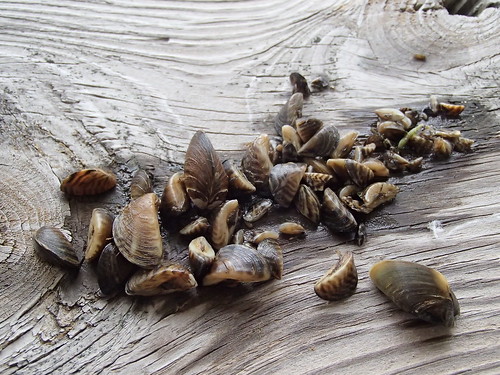More Zebra Mussels Found in Upper Chesapeake Bay

Zebra Mussels
DNR calls on boaters to help prevent further spread of this harmful invasive
As the weather warms and boating season begins, DNR reminds boaters to be on the lookout for zebra mussels and to take precautions to prevent their spread. Department biologists recently found a significant increase in this harmful invasive during their most recent zebra mussel monitoring effort in the upper Chesapeake Bay.
Every fall for the last three years, DNR has inspected marker buoys and anchors as they are brought aboard the Department’s buoy-tending vessel, the A.V. Sandusky, for winter storage. This past fall, there were approximately 35 times more attached mussels and colonized anchors compared to the year prior.
Also during this time, two alert watermen submitted specimens of zebra mussels that had colonized their fishing gear on the Susquehanna Flats. Citizen sightings ─ such as zebra mussel larvae entering water system intakes, and adults attaching to infrastructure ─ help DNR assess trends in the population.
Boaters and anglers who use the lower Susquehanna River and upper Bay can help prevent the spread of zebra mussels to other Maryland waters by taking these precautions:
- Remove all aquatic plants and mud from boats, motors and trailers; and put the debris in trash containers.
- Drain river water from boat motors, bilges, live wells, bait buckets and coolers before leaving to prevent these aquatic hitchhikers from riding along.
- Dispose of unused live bait on shore, far from the river or Bay or in trash containers.
- Rinse boats, motors, trailers, live wells, bait buckets, coolers and scuba gear with high pressure or hot water between trips to different water bodies.
- Dry everything at least two days, and preferably five days, between outings.
- Limit boating from place to place ─ particularly between the Susquehanna and upper Bay to other water bodies in Maryland ─ where zebra mussels haven’t invaded.
DNR also asks that people who live, recreate and work on the water report any suspected sightings to [email protected] or 410-260-8604. More information is available at dnr.maryland.gov/invasives/ZebraMussel.asp, including a reporting form and fact sheet that differentiates zebra mussels from their lookalikes.
Since its inadvertent introduction into the Great Lakes in the mid-1980s, the zebra mussel has spread rapidly throughout freshwater habitats of the United States, causing billions of dollars in damage to infrastructure. In places where they have established, they have out-competed native freshwater mussels, altered aquatic ecosystems and contributed to the rise of harmful algal blooms. In Maryland, they are currently restricted to the lower Susquehanna River and upper Chesapeake Bay, but their impacts are unknown.
